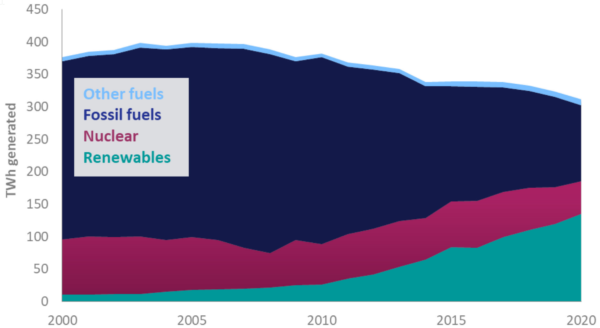UK power generation in 2020: Renewables up to 43%
Solar contributed 28% of the U.K.’s total renewable energy generation, which was dominated by wind power. The proportion of fossil fuels in the energy mix fell to a record low last year, at 37.7%.
Power production from renewable sources again provided record levels of generation in the U.K. last year, with 43% of the nation’s electricity met by sources including wind, solar, and biogas, up from 37% in 2019.
The U.K. government released its Digest of UK Energy Statistics (DUKES) for 2020 today, published by the Department for Business, Energy and Industrial Strategy (BEIS).
The data for total energy generation and consumption last year confirmed plunging fossil fuel generation, and a growing renewables share. Total energy demand, including petroleum fuels for transport, dipped to 1950s-era figures, due to Covid-19 restrictions. Total consumption was down 13%, year-on-year.
In terms of electricity generation, the report highlighted a coal-free period of 67 days from April 10 to June 16, followed by another window of 55 days, to August 12. Coal fell to a 1.8% share of electricity generation while gas peaker plants provided 35.7%.
Growth in renewables outpaced fossil fuels, with the DUKES data showing, since 2010, renewable generation has increased from 6.9% to the current record high.
Electricity generation by fuel, 2000-2020:

Image: DUKES 2021 report, BEIS.
Solar’s role
Solar generation growth has slowed in the U.K., with its share of the renewable mix standing at 28% in 2020. Solar generation grew 4.6% last year, from 2019, largely because of better weather.
Figures from BEIS indicate only 238 MW of solar PV was added during a Covid-19-affected 2020:
| Solar photovoltaics installed capacity (MW): | |
|---|---|
| 2015 | 9,601 |
| 2016 | 11,914 |
| 2017 | 12,760 |
| 2018 | 13,059 |
| 2019 | 13,224 |
| 2020 | 13,462 |
| Solar photovoltaics generation (GWh): | |
|---|---|
| 2015 | 7,533 |
| 2016 | 10,395 |
| 2017 | 11,457 |
| 2018 | 12,668 |
| 2019 | 12,580 |
| 2020 | 13,158 |
A recent survey by BEIS, to understand how to get more solar on rooftops, noted small-and-medium-sized businesses in the U.K. may be forced to pay higher taxes after installing PV. When the issue was raised with survey respondents, it was met with “palpable disbelief and anger.”
The U.K. government commenced a large scale wind down of the solar feed-in tariff (FIT) in 2015.
Wind winners
With 13% of the U.K.’s electricity coming from offshore wind, and 11.1% from onshore turbines, the combined figure reached a record 24.1%, or 75.7 TWh, of U.K. generation in 2020. Capacity increases were said to be modest however favorable wind conditions, including storms in the first quarter, assisted in generation boosts, to notch an increase of 18% compared with the previous year. Offshore wind, in particular, was noted as generating 29% more electricity on a year-on-year basis.
Biogas was the only renewable energy listed as seeing a fall in generation, with the government attributing this to falling extraction rates at landfill gas sites.
Total renewables capacity, including wind and solar, fell to a low of 1 GW-added last year, the lowest amount since 2007 and the slowest growth rate since 2002.
Zero coal
The publication of the latest release of DUKES data comes following the June 30 announcement by the U.K. government that it would bring forward the ban on coal-fired electricity generation by a year, to October 1, 2024.

